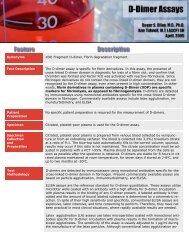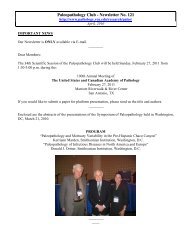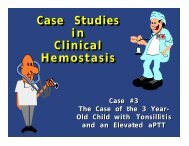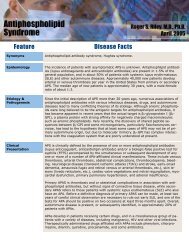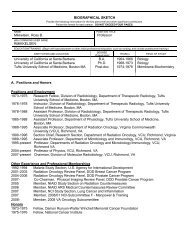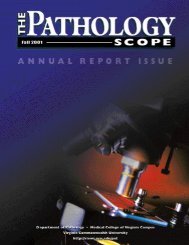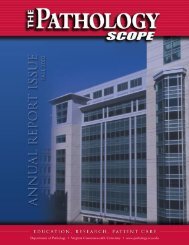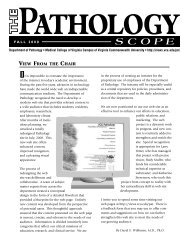Laboratory Monitoring of Warfarin Therapy - Pathology
Laboratory Monitoring of Warfarin Therapy - Pathology
Laboratory Monitoring of Warfarin Therapy - Pathology
Create successful ePaper yourself
Turn your PDF publications into a flip-book with our unique Google optimized e-Paper software.
<strong>Warfarin</strong> <strong>Monitoring</strong><br />
Crystalline warfarin sodium (Coumadin,<br />
Panwarfin, S<strong>of</strong>arin, Coufarin, Athrombin-K) is<br />
the most widely used oral anticoagulant in<br />
the world. <strong>Warfarin</strong> interferes with the hepatic<br />
synthesis <strong>of</strong> the vitamin-K dependent<br />
coagulation factors by interfering with the<br />
vitamin K cycle. <strong>Laboratory</strong> monitoring <strong>of</strong><br />
warfarin therapy is mandatory, since the<br />
agent has a relatively narrow therapeutic<br />
range. The therapeutic efficacy is <strong>of</strong> warfarin<br />
is reduced with an inadequate dose, while there<br />
is a serious risk <strong>of</strong> bleeding with an excess<br />
amount <strong>of</strong> the drug. In addition, the pharmacokinetics<br />
<strong>of</strong> warfarin are significantly influenced<br />
by the diet, other medications, and<br />
many other factors. During the past two decades,<br />
several developments in laboratory science<br />
have helped the clinician to ensure a<br />
proper dosage intensity that decreases the<br />
risk <strong>of</strong> bleeding while maintaining therapeutic<br />
efficacy. These developments include improved<br />
laboratory reagents and instrumentation,<br />
as well as a standardized method for reporting<br />
the prothrombin time (i.e., International<br />
Normalized Ratio, INR). However, a comprehensive<br />
system <strong>of</strong> quality assurance is still<br />
necessary for optimal patient care.<br />
It is imparative that physicians monitoring<br />
warfarinized patients must understand the biological<br />
effect and pharmacokinetics <strong>of</strong> warfarin,<br />
its interaction with other medications, and the<br />
factors affecting the prothrombin time/INR assay,<br />
including the recently discovered impact <strong>of</strong><br />
the CYP2C9 and VKORC1 genetic polymorphisms.<br />
The physician must also work with<br />
other members <strong>of</strong> the patient care team to ensure<br />
that patient identification procedures are<br />
followed and the proper type and amount <strong>of</strong><br />
specimen is submitted for laboratory testing.<br />
<strong>Warfarin</strong> is a synthetic derivative <strong>of</strong> the<br />
naturally occurring anti-coagulant dicumarol.<br />
The anti-coagulant properties <strong>of</strong> dicumarol<br />
were first observed in cattle that suffered a<br />
hemorrhagic disorder after being fed spoiled<br />
sweet clover hay during the 1920s. Karl Link<br />
identified the causative agent by 1939 and<br />
later developed warfarin as a rat poison before<br />
it was used in humans in the 1950s. However<br />
the anticoagulant mechanism <strong>of</strong> warfarin<br />
was not elucidated until twenty years<br />
later.<br />
<strong>Warfarin</strong> is a specific inhibitor <strong>of</strong> the vitamin<br />
K epoxide reductase necessary for the<br />
regeneration <strong>of</strong> vitamin K from vitamin K<br />
2,3-epoxide in vivo (Fig. 1). Vitamin K acts as<br />
a c<strong>of</strong>actor for !-glutamyl carboxylase, which<br />
carboxylates specific glutamic acid residues<br />
in vitamin K dependent proteins. The vitamin<br />
K dependent proteins include coagulation<br />
factors V, VII, IX, and X as well as protein C<br />
and protein S. This post-translational modification<br />
forms !-carboxyglutamic acid residues<br />
that chelate metal ions and allow the proteins<br />
to bind specific c<strong>of</strong>actors on phospholipid<br />
surfaces necessary for normal coagulation.<br />
The carboxylation reaction generates vitamin<br />
K 2,3-epoxide, which must be converted back<br />
to vitamin K by an epoxide reductase to<br />
maintain stores. Inhibition <strong>of</strong> vitamin K epoxide<br />
reductase reduces the availability <strong>of</strong> vitamin<br />
K, which leads to a decrease in the active<br />
forms <strong>of</strong> vitamin K dependent coagulation<br />
factors and ultimately anti-coagulation.<br />
<strong>Warfarin</strong> is currently the only FDA approved<br />
orally available anti-coagulant medication.<br />
It is rapidly absorbed from the gastrointestinal<br />
tract, reaching maximum concentration<br />
90 minutes after administration, with<br />
a half-life <strong>of</strong> 36 to 42 hours. However, the<br />
pharmacokinetics <strong>of</strong> warfarin can by highly<br />
variable. It circulates bound to albumin and is<br />
metabolized in the liver. Genetic variation in<br />
a cytochrome P450 enzyme alters the dose-<br />
<strong>Warfarin</strong> Structure, Metabolism, Pharmacokinetics 2





